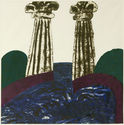
19th, 20th & 21st Century Fine Prints
707-546-7352 · fax 707-546-7924 · web: www.annexgalleries.com · email: artannex@aol.com
Carol Summers Biography
Carol Summers
American
1925–2016
Biography
Printmaker Carol Summers was born on December 26, 1925 in Kingston, New York, and was raised in nearby Woodstock. His parents Ivan and Theresa Summers were both artists who had met in art school in St. Louis. During the Great Depression, when Carol was growing up, his father supported the family as a medical illustrator until he could return to painting. As well, he taught summers at Arizona State Teachers College where he instructed woodcut printmaking, which was the first time Carol was exposed to the medium. His mother was a watercolorist, and passed on her knowledge of the medium to Carol as well as her interest in paper and papermaking. Many years later, Summers would sometimes paint or print on thinly textured paper originally collected by his mother.
After a stint as a navigator bombardier in World War II, he returned to the states and under the G.I. Bill he trained in classical fine and studio arts at Bard College (1948-1951) studying painting with Steven Hirsh and printmaking with Louis Schanker, and in the summer of 1949 he studied at the Art Students League under Arnold Blanch. In 1954, he began teaching with a post at Haystack Mountain School of Crafts in Libery, Maine and the Brooklyn Museum School of Art. He applied for and was given a grant from the Italian government to study for a year in Italy in 1955, where he traveled throughout Tuscany and beyond, garnering inspiration from the landscapes, architecture, and Old Master art he was exposed to.
Around this same time, along with fellow artist Leonard Baskin, Summers pioneered what is now referred to as the “monumental” woodcut. This term was coined in the early 1960s to denote woodcuts that were dramatically bigger than those previously created in earlier years, which were limited to the size of the matrices of small hand presses. Summers ultimately refined a relief printmaking process akin to stone rubbings, which would eventually be called the “Carol Summers Method” or the “ Carol Summers Technique.”
Technically proficient and endlessly experimental, he delevoped this printing method in reaction to the rigidity of the Japanese method, in which the artist applies ink directly to sharply-carved blocks, allowing for little variation, before printing images in reverse, a result he found "disconcerting". Wanting less predictability and softer edges, he found a way to saturate the surface of the paper with ink - usually a mulberry laid - while still allowing for just enough control to keep the colors from running together. Before printing, he centered a dry sheet of paper over the top of the cut wood block or blocks, securing it with giant clips, then rolled the ink directly on the front of the sheet of paper while pressing down onto the dry wood - similar to a rubbing. After the ink was applied to the front of the paper, Summers sprayed it with mineral spirits which acted as a thinning agent. The absorptive fibers of the paper drew the thinned ink away from the surface, softening the shapes and diffusing and muting the colors. This produced a unique glow that is a hallmark of the Summers printmaking technique.
By following his own method, Summers avoided the mirror-reversed image of a conventional print, allowing him control over the precise amount of ink that he wanted on the paper. In the majority of his woodcuts he made the blocks slightly larger than the paper so the image and color would bleed off the edge. He worked indpendently, cutting, inking, and pulling the works himself. His woodcuts revealed a sensitivity to wood, especially its absorptive qualities and the subtleties of the grain, which he often incorporated into his works.
Summers' traveled widely and frequently, garnering inspiration from the colors and natural landscapes of the Northwestern United States, Mexico, India, the Himalayas, and more. He taught throughout the U.S., including the Pratt Graphic Art Center, NY (1962), Hunter College, NY (1963), School of Visual Arts, NY (1966), College Art Study Abroad, Paris (1967), Pennsylvania State University, PA (1968), San Francisco Art Institute, San Francisco, CA (1973), in India through the United States Information Agency (1974, 1979), and more. He moved to California in the 1970s, where he remained until his death in Santa Cruz on October 27, 2016.
Awards and Fellowships:
Italian Government Grant for Study in Italy, 1955
Louis Comfort Tiffany Foundation Fellowship, 1955, 1960
John Simon Guggenheim Foundation Fellowship, 1959
Honorary Doctorate in Fine Art, Bard College, 1974
Selected Solo Exhibitions:
1954: Acrt Society of Albany, NY
1955: Academia Degli Intronati, Siena, Italy
1964 - 1966: Musem of Modern Art, NY: Traveling Exhibition
1965: Lowe Art Museum, Miami, FL
1966: DeCordova Museum, Lincoln, Nebraska
1967: San Francisco Museum of Modern Art, SF, CA; Washing Gallery of Modern Art, Washington, D.C.
1974, 1982: American Library, New Delhi, India
1975: Roledo Museum of Art, Toledo, Ohio
1977: Brooklyn Museum of Art, NY
1978: Cranbrook Academy, Bloomfield, Michigan
1983: University of California at Santa Cruz
1986: El Camino College, Torrance, CA
1986: American Center, Islamabad, Lahore, and Karachi, Pakistan
Selected Collections:
Accademia Degli Intronati, Siena, Italy; Art Institute of Chicago, IL; Baltimore Museum of Fine Arts, MD; Bibliotheque Nationale, Paris; Boston Museum of Fine Arts, MA; Brooklyn Museum, NY; Corcoran Gallery of Art, Washington, D.C.; DeCordova Museum, Lincoln, NB; Detroit Museum of Art, MI; Kunstmuseum, Malmo, Sweden; Kunstmuseum, Basel, Lugano, and Freunchen, Swizterland; Library of Congress, Washington, D.C.; Los Angeles County Museum of Art, CA; Metropolitan Museum of Art, NY; Museum of Modern Art, NY; National Museum, Poznan, Lodz, and Szczecin, Poland; New Britain Art Institute, New Britain, CT; New York Public Library, NY; Philadelphia Museum of Art, PA; San Francisco Museum of Modern Art, CA; Seattle Museum of Art, WA; Victoria and Albert Museum, London; Walker Art Center, Minneapolis, MN



